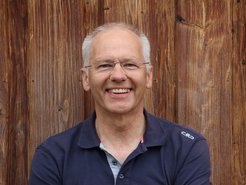Axel Schwope
"I was always interested in reasons, why are things as they are?"

Life
My name is Axel Schwope, born in Berlin, studied in Berlin, PhD and habilitation also there. I am senior research scientist at the Leibniz-Institut für Astrophysik Potsdam (AIP) and head of the X-ray astronomy group. I am Privatdozent at the University of Potsdam, for a while I was adjunct faculty at NMSU (New Mexico State University).
I was always interested in reasons, why are things as they are? What can we know, at least in principle. What cannot be known. Astronomy was one way to deal with such questions in a professional manner. I’m still amazed what level of detail we find out about objects zillions of kilometers away by doing nothing else than measuring and weighing.
Science
My interest is on compact objects with a specialization on close white-dwarf binaries and isolated neutron stars. This is also my field of interest in eROSITA because many of these are X-ray emitters. With eROSITA we expect to find the true population of sources while in the past we have perhaps merely discovered the bright exotic objects. Based on our new census we will quantify their role in the galactic context, quantify the high-energy output of the Milky Way, and create the observational basis to model the evolution of compact objects. In the German eROSITA consortium I serve on various committees, among them the working group ‘Compact Objects’, which I am happy to chair.
X-rays is just one aspect to study my objects of interest. To understand the physics of our objects fully, we need data from other wavelength ranges. I was very much involved establishing the art of Doppler tomography as analytical tool, based on optical spectroscopy of rotating objects. The velocity maps generated by these methods (see picture) fired our inspirations how mater interacts with magnetic fields in interacting binaries.
Great Scientific Moment
I was sitting in the control room of the Danish 1.5 m telescope at ESO, Chile. We were observing new objects that were discovered with ROSAT, the predecessor of eROSITA. Suddenly the night assistant reported that our object was gone, it vanished from the TV screen, left no signal behind. Was a cloud covering the telescope? No, clear sky! Was the telescope dome shielding the clear sky? No, telescope was staring through the dome slit. Was there an instrument failure? No, it worked properly. We had to wait 1o minutes, then our object suddenly re-appeared as bright as before. We had discovered, just coincidentally, a super-deep, astonishingly long, eclipse of a compact white dwarf star by another star shielding it. Jackpot.
Future Projects
We are looking forward into the near future to identify all the precious new detections made with eROSITA optically with the SDSS5 and the 4MOST surveys and we are preparing ourselves for the next big thing in X-ray astronomy, the ESA L-class mission ATHENA.
Hobbys
In my spare time, I like singing, playing the guitar, hiking, and juggling.












